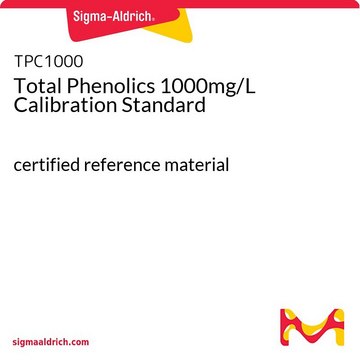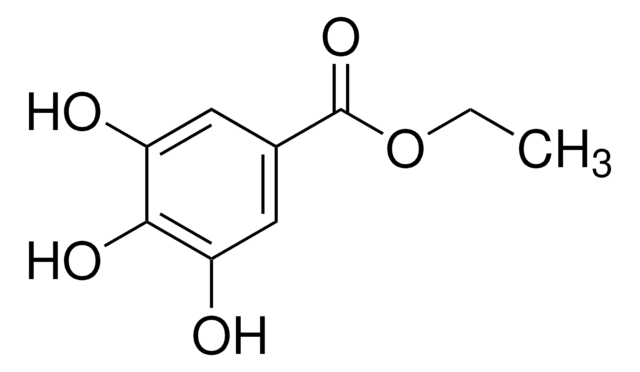48688
Fenol
certified reference material, 500 μg/mL in methanol
About This Item
Produtos recomendados
grau
certified reference material
TraceCERT®
Nível de qualidade
Agency
EPA TO-8
NIOSH 2001
OSHA 32
linha de produto
TraceCERT®
Certificado de análise (CofA)
current certificate can be downloaded
Características
standard type calibration
embalagem
ampule of 1 mL
concentração
500 μg/mL in methanol
técnica(s)
HPLC: suitable
gas chromatography (GC): suitable
aplicação(ões)
cleaning products
cosmetics
environmental
food and beverages
personal care
Formato
single component solution
temperatura de armazenamento
2-30°C
cadeia de caracteres SMILES
Oc1ccccc1
InChI
1S/C6H6O/c7-6-4-2-1-3-5-6/h1-5,7H
chave InChI
ISWSIDIOOBJBQZ-UHFFFAOYSA-N
Informações sobre genes
human ... GABRA1(2554)
Procurando produtos similares? Visita Guia de comparação de produtos
Descrição geral
Aplicação
Outras notas
Informações legais
Não está encontrando o produto certo?
Experimente o nosso Ferramenta de seleção de produtos.
Palavra indicadora
Danger
Frases de perigo
Declarações de precaução
Classificações de perigo
Acute Tox. 3 Dermal - Acute Tox. 3 Inhalation - Acute Tox. 3 Oral - Flam. Liq. 2 - STOT SE 1
Órgãos-alvo
Eyes,Central nervous system
Código de classe de armazenamento
3 - Flammable liquids
Classe de risco de água (WGK)
WGK 2
Ponto de fulgor (°F)
49.5 °F - closed cup
Ponto de fulgor (°C)
9.7 °C - closed cup
Escolha uma das versões mais recentes:
Já possui este produto?
Encontre a documentação dos produtos que você adquiriu recentemente na biblioteca de documentos.
Artigos
Separation of 2-Chlorophenol; 2,4-Dichlorophenol; 2,4,6-Tribromophenol; 2,4,6-Trichlorophenol; 2,4-Dinitrophenol; Pentafluorophenol; 2-Methylphenol, analytical standard; 2,3,4,6-Tetrachlorophenol; Pentachlorophenol; 4-Nitrophenol; 2-Bromophenol; 2,3,5,6-Tetrachlorophenol; 2,3,5-Trichlorophenol; 4-Chloro-3-methylphenol; 2,4,5-Trichlorophenol; 4-Methylphenol, analytical standard; 2,4-Dimethylphenol; 2-Nitrophenol; 3-Methylphenol, analytical standard; Phenol; 2-Methyl-4,6-dinitrophenol; 2,3,4-Trichlorophenol; 2,6-Dichlorophenol; 2,3,4,5-Tetrachlorophenol
Protocolos
HPLC Analysis of Cresols and Phenol on Astec® CYCLOBOND® I 2000
Separation of 2-Nitrophenol; Pentachlorophenol; 2-Bromophenol; Phenol; 4-Nitrophenol; 3-Methylphenol, analytical standard; 4-Chloro-3-methylphenol; 2,4-Dichlorophenol; 2,3,4,6-Tetrachlorophenol; 2-Methylphenol, analytical standard; 2,4,6-Trichlorophenol; 2,4-Dimethylphenol; 2-Chlorophenol
HPLC Analysis of Phenols on SUPELCOSIL™ LC-8
Nossa equipe de cientistas tem experiência em todas as áreas de pesquisa, incluindo Life Sciences, ciência de materiais, síntese química, cromatografia, química analítica e muitas outras.
Entre em contato com a assistência técnica




